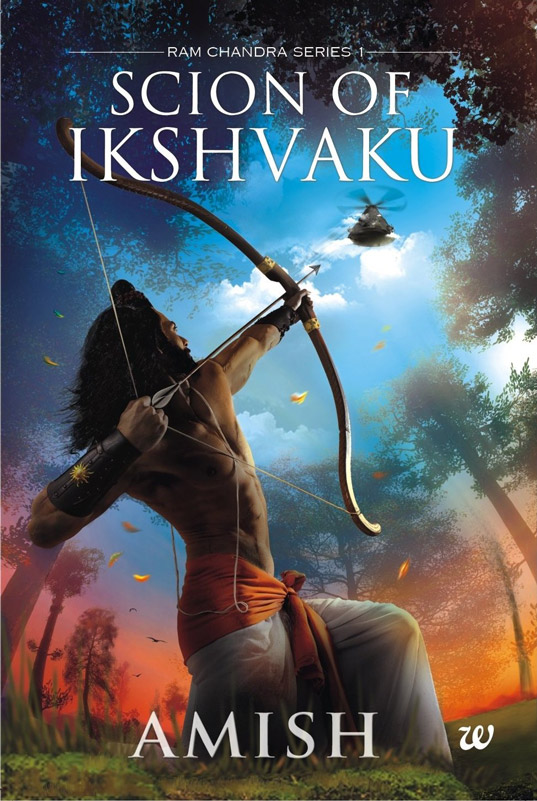“Scion of Ikshvaku” is the latest book by Amish Tripathi who is known for his earlier work “Shiva’s Trilogy” which sold over two million copies. Like in Shiva’s Trilogy (ST), Scion of Ikshvaku (SOI) is a work of fiction which reimagines Indian mythology. In the former Lord Shiva was retold by Amish to be a Tribal head from Tibet, in the latter Lord Ram remains closer to his role in Epic Ramayana but is disliked by his father Emperor Dashrath for being born on the day he tasted his first loss in a battle.
I had pre-ordered in Amazon the first part of Ram Chandra Series, got the book promptly delivered by 8AM on June 22, the launch day. The story starts in 3400 BC near Godavari River where Prince Ram & Prince Lakshman are hunting a Deer for food, when they hear the scream of Lady Sita being kidnapped by Lankan King Raavan in his Pushpak Vimaan (his flying vehicle). Amish then leads us to 33 years in the past just before Ram was born, to a battle field in western coast of Sapt Sindhu, narrating the happenings of the battle, the decline of Ayodhya’s glory, the birth and growing up of Ram & his brothers, their education under Maharishi Vashishta, Ram being asked to help Maharishi Vishwamitra, Ram‘s wedding with Lady Sita and Ram‘s self banishment for fourteen years for breaking Lord Rudra’s diktat.
Amish has proven once again he is an ace storyteller of Indian mythology, his strength being the pace of his narration which is breath taking, and his vivid description of happenings especially battle formations and combat trainings. When Amish takes you to a new city, just by his words you could see a 3D version of the entire city clearly in your mind, in this book too you get to go back in time and experience Ayodhya & it’s grand canals and the city of Mithila. Just like how Immortals of Meluha captivated the reader by being familiar yet new, Ram Chandra Series’ first book is set on familiar grounds but in Amish‘s scintillating imagination. I enjoyed reading the book and I awaiting eagerly for the next part.
Author has sprinkled throughout the book his interpretation of Hinduism, his understanding of Indian philosophy which travels in the safe zone between the old & new, a convenient position that’s sure to appeal to the sentiments of educated Indian middle class – his target market. Compared to Shiva’s trilogy, as a reader I felt the dosage of Amish‘s philosophy told through Ram seems to have been overdone in SOI.
When reading the book, I wanted to avoid thinking about Meluha and comparing the two series, but as much as I tried the similarities were striking on my face and were repeating. Ram‘s combat training, his archery technique, battle planning reminded me that of Shiva‘s. Sita‘s character was made from the same mould of Sati (Siva’s wife), both are beautiful, trained warriors who lead and fight battles, both happen to be older than their respective husbands and both seek help from Survavanshi’s outcasts the Nagas for their protection. Somras,the anti-aging miracle drug played a central role in ST it seems to be taking a similar role in SOI. Lady Ayurvati was the royal physician and so is Lady Nilanjana, Both Emperor Daksha and Emperor Dashrath are weakened version of their former self when the protagonist (Shiva and Ram) enters their respective life. If Lord Bhrigu was the kingmaker in ST, it is Maharishi Vishwamitra who seems to be playing the role in SOI. Parvateshwar was Chief of Armed forces of Meluha who was a foe turned friend for Shiva, similarly Mrigasya the general of Dashrath’s army becomes an ally of Ram. Brahaspati plays an important facilitating role to Shiva, Maharishi Vashishta as Guruji to Ram does that advisory role.
There are many puzzling questions you get when you are reading the book. How come in the battle at Mithila, King Janak ruler of Mithila or his younger brother King Kushadhwaj were not involved or even consulted in the battle with Ravaan outside their fort; why is Ram & Sita spearheading the attack?. The description by Amish of how Ram fires the daivi astras looks erringly similar to Shiva doing the same outside Meluha. The inclusion of an incident resembling closely to gruesome Delhi gang rape sticks out as unnecessary and gives an impression of author wanting to showcase his democratic credentials.
In summary, Immortals of Meluha was imaginative and hence enchanting its readers; in contrast Scion of Ishvaku delights its readers but doesn’t feel original.

Scion of Ikshvaku

